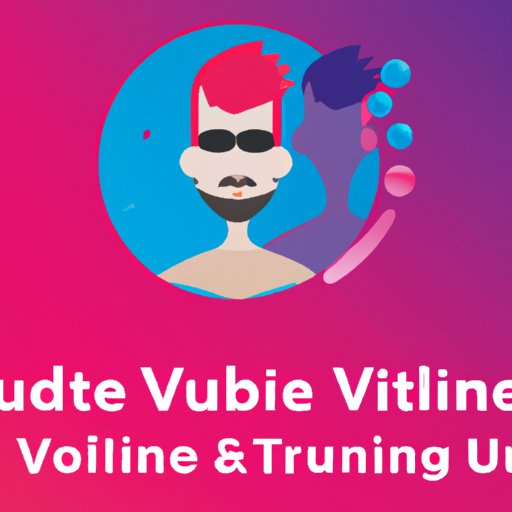Introduction
VTubing, or virtual YouTubing, is a phenomenon that has taken the online world by storm. It involves the use of digital avatars to create content and interact with viewers, blurring the lines between reality and the virtual world. VTubers are a rapidly growing community of content creators who have gained a massive following in recent years, thanks to their unique approach to content creation. In this article, we will explore the fascinating world of VTubing from its technical aspects to its cultural and economic impact, and everything in between.
The Technical Side of VTubing
VTubing requires a combination of hardware and software to bring the digital avatar to life. To start, you need a motion capture system, which tracks the movements of the person behind the avatar. This system includes cameras, sensors, and microphones. The motion data is then translated into movements for the digital avatar using specialized software, such as Live2D and FaceRig.
VTubers also need high-speed internet, a powerful computer or laptop, and a camera to stream their content. Streaming software such as OBS and XSplit are also required to manage the live videos. All of this technology can be expensive and challenging to set up, especially for those who are not tech-savvy.
The challenges faced by VTubers when creating content include maintaining the illusion of being a digital avatar, developing engaging content, and keeping up with the technology as it evolves. However, the creative freedom and potential for reaching a global audience make it worth the effort for many VTubers.
VTubing 101: Tips for Starting Your Own Channel
When starting a VTuber channel, the first thing you need to do is create a persona for your digital avatar. This can be based on an existing character or an original creation. It’s essential to think carefully about your persona, as it will represent you in the virtual world. Once you have a persona, it’s time to start building an online presence by creating social media accounts and YouTube channels.
To create engaging content, it’s crucial to have a clear idea of your audience and what they expect from your channel. You should also plan your content to ensure consistency and keep your viewers engaged. Other tips include upgrading equipment and software as your channel grows and collaborating with other VTubers to expand your audience.
The Cultural Impact of VTubing on Social Media and Pop Culture
VTubing is changing the way people consume online content and how they view digital identities. The use of digital avatars allows creators to explore different personas, and viewers can interact with them in a more personal way. VTubing is also reflective of changing societal attitudes towards digital identities, as more and more people embrace the idea of creating a virtual version of themselves.
Several VTubers have gained a massive following and become cultural icons, such as Kizuna AI and Hololive, and their popularity shows no sign of slowing down. They have created a new form of entertainment that combines gaming, anime, and social media, appealing to a wide audience.
The Business of VTubing: Monetizing Your Virtual Persona
The success of many VTubers has led to increased interest from brands and companies looking to market their products to a global audience. Some VTubers make money from advertising revenue, merchandise sales, and fan donations through platforms such as Patreon and Twitch. Brands are also collaborating with VTubers, such as Kizuna AI’s successful partnership with Coca-Cola Japan and Hololive’s collaboration with the mobile game Azur Lane.
The monetization of VTuber content has raised some concerns about the authenticity of the content, and whether it is still a genuine expression of the creator or merely a marketing tool. However, most VTubers strive to maintain a balance between monetization and authenticity, ensuring that their content remains true to their vision.
Breaking the Fourth Wall: How VTubing Blurs the Line Between Digital and Real Life
VTubing challenges traditional notions of identity, as creators assume a new persona and interact with people using a digital avatar. The line between the virtual and real world becomes blurred, as creators and viewers alike create meaningful connections through their avatars.
Real-life events and interactions further blur the line between the creator and their virtual persona, such as when Kizuna AI revealed her true identity as several voice actresses and actors or Hololive’s collab with TikTok star Bella Poarch. As technology improves and our interaction with the virtual world becomes more immersive, there will be even greater potential for creators to experiment with this concept.
VTubing and the Future of Entertainment: Trends to Watch in the Virtual World
VTubing will continue to evolve as technology advances, creating even more opportunities for creators to connect with their audience. Emerging technologies such as virtual and augmented reality will enhance the VTuber experience, bringing viewers even closer to their favorite virtual personalities.
As VTubing grows in popularity, it will undoubtedly impact traditional entertainment industries such as television and movies. The potential for creating unique and personalized content through the use of digital avatars could revolutionize the way entertainment is produced and consumed.
Conclusion
VTubing is an exciting new trend that combines technology, entertainment, and creativity. It has the potential to change the way we consume online content and how we view digital identities. Whether you’re a VTuber or a viewer, the impact of this phenomenon is impossible to ignore. As technology continues to advance, we can expect even more exciting developments in the world of VTubing, and we can’t wait to see what the future holds.
(Note: Is this article not meeting your expectations? Do you have knowledge or insights to share? Unlock new opportunities and expand your reach by joining our authors team. Click Registration to join us and share your expertise with our readers.)
